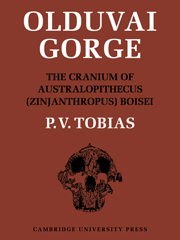Book contents
- Frontmatter
- Contents
- List of text-figures
- List of plates
- List of tables
- Introductory Note
- Foreword
- Editor's Note
- Acknowledgements
- I Introduction
- II Preservation and reconstruction of the cranium
- III The cranial vault
- IV The basis cranii externa
- V Certain critical angles and indices of the cranium
- VI The interior of the calvaria
- VII The thickness of the cranial bones
- VIII The endocranial cast of Zinjanthropus
- IX Metrical characters of the calvaria as a whole
- X The structure of the face
- XI The pneumatisation of the Zinjanthropus cranium
- XII The dental arcade and the palate
- XIII The pattern of dental attrition and occlusion, with comments on enamel hypoplasia
- XIV The size of individual teeth, absolute and relative
- XV The size of the dentition as a whole
- XVI The crown shape index of the teeth
- XVII The morphology of the teeth
- XVIII Summary of cranial and dental features of Zinjanthropus
- XIX The taxonomic status of Zinjanthropus and of the australopithecines in general
- XX The cultural and phylogenetic status of Australopithecus boisei and of the australopithecines in general
- References
- Index of persons
- Index of subjects
- Plate section
XVI - The crown shape index of the teeth
Published online by Cambridge University Press: 05 November 2011
- Frontmatter
- Contents
- List of text-figures
- List of plates
- List of tables
- Introductory Note
- Foreword
- Editor's Note
- Acknowledgements
- I Introduction
- II Preservation and reconstruction of the cranium
- III The cranial vault
- IV The basis cranii externa
- V Certain critical angles and indices of the cranium
- VI The interior of the calvaria
- VII The thickness of the cranial bones
- VIII The endocranial cast of Zinjanthropus
- IX Metrical characters of the calvaria as a whole
- X The structure of the face
- XI The pneumatisation of the Zinjanthropus cranium
- XII The dental arcade and the palate
- XIII The pattern of dental attrition and occlusion, with comments on enamel hypoplasia
- XIV The size of individual teeth, absolute and relative
- XV The size of the dentition as a whole
- XVI The crown shape index of the teeth
- XVII The morphology of the teeth
- XVIII Summary of cranial and dental features of Zinjanthropus
- XIX The taxonomic status of Zinjanthropus and of the australopithecines in general
- XX The cultural and phylogenetic status of Australopithecus boisei and of the australopithecines in general
- References
- Index of persons
- Index of subjects
- Plate section
Summary
The postcanine teeth tend to be enlarged buccolingually far more than mesiodistally. Metrical expression can be given to this tendency by the calculation of the crown shape index, in which the m.d. crown diameter is expressed as a percentage of the b.l. diameter. In Table 45, the m.d./b.l. shape indices of Zinjanthropus are compared with those of a number of other hominoids. Two distinct trends seem to characterise the hominoids listed: one is a tendency towards relative buccolingual expansion from C to the premolars, resulting in most groups in progressively lower mean indices from before backwards; the other is a similar gradient starting at M1 and decreasing through to M3.
The canine–premolar trend shows the most marked drop from C to P3; this is true in Australopithecinae (including Zinjanthropus), Homininae and Pongidae. The decrement in shape index from P3 to P4 is slight throughout these hominoids, but there are several exceptions in which P4 has a slightly higher index than P3. Zinjanthropus is one of them. Sangiran IV and Rabat are further examples, so that the overall picture in Homo erectus shows a mean shape index of P4 which is a shade higher than that of P3. The mean values for the male gorilla sample of Ashton and Zuckerman (1950) provide another instance. However, when one considers single specimens of Paranthropus and Australopithecus, in which both maxillary premolars are present and measurable on at least one side, the Zinjanthropus pattern finds a parallel in several examples of both forms.
Information
- Type
- Chapter
- Information
- Olduvai Gorge , pp. 172 - 174Publisher: Cambridge University PressPrint publication year: 1967
